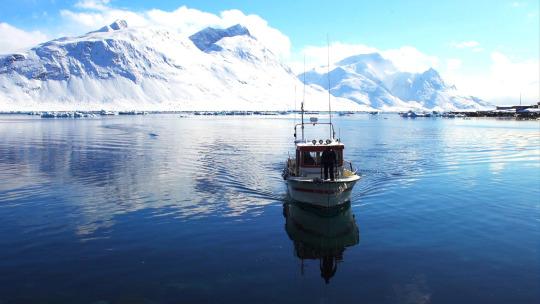When I went to Greenland in April, there was nothing I was looking forward to more than sailing through the country’s fjords and seeing the polar ice cap up close — plus possibly spying a polar bear. These things are all beautiful, but each also has a darker history.
The (disappearing) ice sheet, which is around 110,00 years old, covers 80 percent of the country and is 3 kilometers thick at its deepest point, but is generally 2 kilometers thick. The glaciers spread over the middle of the country and flow outward, breaking off in the fjords, which are filled with icebergs and sheets of floating ice called floes.

Sailing around the fjords is dangerous. Just as in “Titanic,” only the tip of the bergs flowing around you are visible. “You have to be very, very careful when sailing around here,” said my guide, Yakob Mathiassen. “But we are fine — we have an Inuit boat driver.”
Related: The Newest Gastro Hot Spot Is… Greenland? No, Really!
It’s beautiful, but global warming is changing things. The ice sheet decreased 16 percent from 1979 to 2002, and as a result, polar bears — which generally stay to the very north of the country — have been coming south.
“There was one they had to shoot last year because it got too close to Nuuk City central,” Mathiassen said. “The theory is he came down and around the tip of the country on an ice floe with the current.”
(Fun fact: If you run into a polar bear and you don’t have a weapon, do not run away. They can run 40 miles per hour, so you can’t outrun them — you have to try to distract them. To do so, you have to get naked. Seriously. Take a piece of clothing off. Drop it on the ground and back away slowly. Then take another item off and back away slowly. Repeat until you are naked (ish) and then run. “Polar bears are very curious,” Mathiassen said. “They will inspect, bite, or play with objects they come across. Leave enough clothes for them to forget about you and run as fast as you can.”)

As you sail along the coast of Greenland, you also see picturesque but empty settlements. In the beginning of the 20th century, Nuuk was not the capital. At that time, most of the country’s population, which now stands at 50,000, was in small settlements which ranged from a few families to a thousand people dotted along the coast. People lived by hunting and foraging what they could. Supplies, mail, and even schools were shipped in.
Then, under Danish rule, it was deemed too expensive to continue weekly or monthly shipping to all of the settlements. So in the 1970s, many residents were given a choice: Move to Nuuk or live out in the wild with no basic services.
This resettlement policy created the ghost towns along the Greenland coast — and many of the social problems that exist today. There is a severe shortage of housing, and high unemployment. “The waiting list for some apartments in Nuuk is 20 years,” Mathiassen said. “And because these were hunters and fishermen, they didn’t have skills for a larger community. There needs to be skill development and job training.”

Check out the Ice Pops!